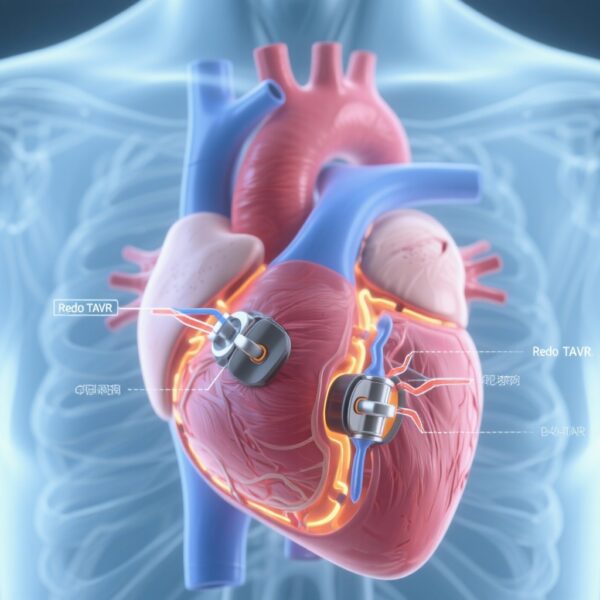Highlight
- Professional guidelines recommend pacemaker implantation in asymptomatic DM1 patients based on ECG or EPS conduction parameters.
- In a cohort of 706 DM1 patients, His-ventricular (HV) interval measured through EPS was a stronger predictor of major bradyarrhythmic events (MBAEs) than ECG PR or QRS durations.
- Lowering the HV interval threshold to ≥65 milliseconds increased sensitivity for identifying high-risk patients and improved reclassification performance.
Study Background and Disease Burden
Myotonic dystrophy type 1 (DM1), a multisystemic autosomal dominant neuromuscular disorder, presents substantial challenges for cardiac management. Progressive conduction system disease is a cardinal feature contributing to morbidity and mortality, with sudden cardiac death due to arrhythmias being a major concern. Early detection of conduction delays allows preemptive pacemaker implantation to prevent fatal bradyarrhythmias. Professional practice guidelines currently endorse pacing in asymptomatic patients with conduction abnormalities defined by ECG parameters—specifically PR interval ≥240 ms and/or QRS duration ≥120 ms—or by electrophysiologic criteria, namely HV interval ≥70 ms during invasive electrophysiological study (EPS). However, the relative predictive value of ECG compared with EPS in this population remains unclear.
Study Design
This investigation was a retrospective cohort analysis utilizing longitudinal data from the DM1 Heart Registry, encompassing six French university hospitals with expertise in cardiology and neurology. The registry includes adults with genetically confirmed DM1, enrolled from 2000 through 2020. This study focused on 706 patients who had undergone their first EPS after 1999 and had no prior advanced atrioventricular (AV) block or sustained ventricular tachycardia. The primary exposure strategies were ECG-based criteria (PR ≥240 ms and/or QRS ≥120 ms) and EPS-measured HV interval (≥70 ms). The main outcome assessed was major bradyarrhythmic events (MBAEs), composite of sudden cardiac death, resuscitated cardiac arrest, or second-degree type II or complete AV block, with follow-up data analyzed through mid-2025. Statistical analyses included multivariable Cox regression and joint modeling incorporating both baseline and time-varying conduction parameters.
Key Findings
Among the 706 patients (mean age 42±13 years; 51% male), 273 (38%) met the EPS criterion (HV≥70 ms), and 232 (32%) met ECG criteria at baseline. Over a median follow-up of 5.9 years (IQR 2.3–9.7), 99 patients (14%) experienced an MBAE.
Multivariable analyses adjusting for conduction intervals demonstrated the HV interval as the only significant predictor of MBAEs. Hazard ratios for MBAEs were stronger with EPS criterion (HR 2.89, 95% CI 1.92–4.34) compared to ECG criteria (HR 1.95, 95% CI 1.31–2.89). Moreover, sensitivity analysis revealed that the EPS strategy had substantially higher sensitivity (68.35% ± 6.24%) compared to ECG (34.76% ± 6.47%), reflecting superior performance in identifying at-risk individuals.
The EPS-based strategy improved patient reclassification accuracy, correctly reclassifying 28.8% of those experiencing an MBAE. Further, redefining the HV interval threshold from 70 ms to 65 ms significantly enhanced detection sensitivity to 90.18% ± 3.85%, with a net reclassification improvement of 33.7% (95% CI 19.6%–48.2%).
These data collectively establish EPS as a more reliable, sensitive, and clinically informative tool than traditional ECG parameters for predicting life-threatening conduction disturbances in DM1.
Expert Commentary
This landmark analysis robustly supports the primacy of invasive electrophysiological assessment over noninvasive ECG for risk stratification in DM1 cardiac conduction disease. The results align with the pathophysiological understanding that HV interval directly reflects the conduction velocity through the His-Purkinje system, which correlates closely with impending AV block risk.
While ECG remains an accessible screening modality, its limitations in sensitivity and predictive value in this population necessitate adjunctive EPS evaluation. The notable improvement by lowering the HV threshold to 65 ms merits consideration for guideline revisions to optimize prophylactic pacing decisions.
Some limitations include the retrospective design and selection bias inherent in patients undergoing EPS, which may restrict generalizability. Nevertheless, the multicenter registry’s large sample and prolonged follow-up strengthen the evidence base. Prospective studies could further validate these findings and refine risk stratification algorithms.
Conclusion
In adults with genetically confirmed myotonic dystrophy type 1, electrophysiological study with HV interval measurement surpasses electrocardiographic parameters in predicting major bradyarrhythmic events, including sudden cardiac death and advanced AV block. Adopting an HV interval cutoff of ≥65 ms offers improved sensitivity for identifying patients who might benefit from timely pacemaker implantation.
These findings advocate for the integration of EPS into routine cardiac evaluation of DM1 patients to enhance prevention of fatal conduction disturbances. Refinement of clinical guidelines to incorporate these insights can facilitate personalized, effective cardiac care in this high-risk population.
References
1. Clementy N, Labombarda F, Grolleau F, et al. Electrocardiogram vs Electrophysiological Study and Major Conduction Delays in Myotonic Dystrophy Type 1. JAMA Cardiol. 2025 Sep 24:e253055. doi: 10.1001/jamacardio.2025.3055.
2. Wahbi K, et al. Cardiac involvement in myotonic dystrophy type 1. Curr Opin Cardiol. 2020.
3. Groh WJ, et al. Prevention of sudden cardiac death in myotonic dystrophy. Heart Rhythm. 2021.



